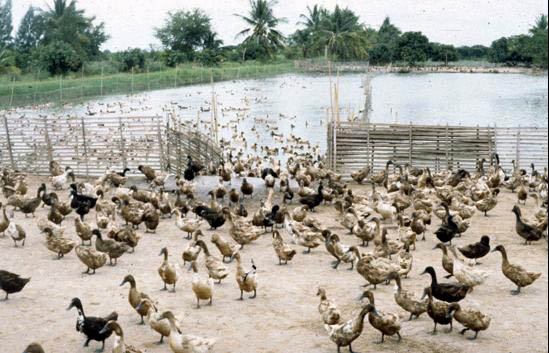|
Duck-Fish Culture
Duck-fish integration is the most common integration in China, Hungary, Germany,
Poland, Russia and some parts of India. A fish-pond being a semi-closed biological
system with several aquatic animals and plants, provide excellent disease-free environment
for ducks. In return ducks consume juvenile frogs, tadpoles and dragonfly, thus
making a safe environment for fish. Duck dropping goes directly in pond, which in
turn provide essential nutrients to stimulate growth of natural food. This has two
advantages, there is no loss of energy and fertilization is homogeneous. This integrated
farming has been followed in West Bengal, Assam, Kerala, Tamil Nadu, Andhra Pradesh,
Bihar, Orissa, Tripura and Karnataka. Most commonly used breed for this system in
India is the ‘Indian runners’.
It is highly profitable as it greatly enhances the animal protein production in
terms of fish and duck per unit area. Ducks are known as living manuring machines.
The duck dropping contain 25 per cent organic and 20 per cent inorganic substances
with a number of elements such as carbon, phosphorus, potassium, nitrogen, calcium,
etc. Hence, it forms a very good source of fertiliser in fish ponds for the production
of fish food organisms. Besides manuring, ducks eradicate the unwanted insects,
snails and their larvae which may be the vectors of fish pathogenic organisms and
water-borne disease-causing organisms infecting human beings. Further, ducks also
help in releasing nutrients from the soil of ponds, particularly when they agitate
the shore areas of the pond.
For duck-fish culture, ducks may be periodically allowed to range freely, or may
be put in screened resting places above the water. Floating pens or sheds made of
bamboo splits may also be suspended in the pond to allow uniform manuring. The ducks
may be stocked in these sheds at the rate of 15 to 20/m2. It is better if the ducks
are left in ponds only until they reach marketable size. Depending on the growth
rate of ducks, they may be replaced once in two to three months. About 15-20 days
old ducklings are generally selected. The number of ducks may be between 100 and
3,000/ha depending on the duration of fish culture and the manure requirements.

Duck-fish integrated system
For culturing fish with ducks, it is advisable to release fish fingerlings of more
than 10 cm size, otherwise the ducks may feed on the fingerlings. The stocking density
of fingerlings also depends on the size of pond and number of ducks released in
it. As the nitrogen-rich duck manure enhances both phyto- and zooplankton production,
phytoplankton-feeding silver carp and zooplankton-feeding catla and common carp
are ideal for duck-fish culture. The fish rearing period is generally kept as one
year and under a stocking density of 20,000/ha, a fish production of 3,000-4,000
kg/ha/year has been obtained in duck-fish culture. In addition to this, eggs and
duck-meat are also obtained in good quantity on an annual basis.
Top
|